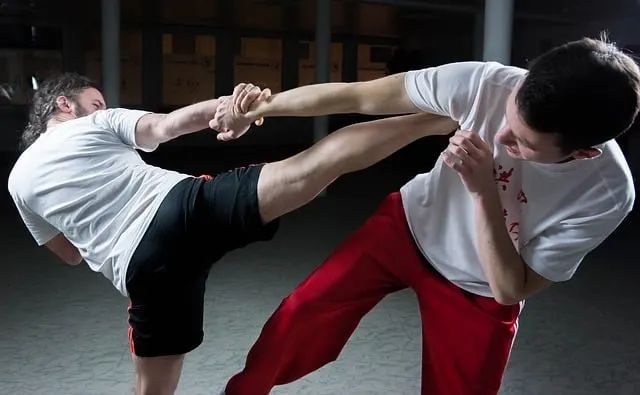
If you are interested in studying a martial art, you probably want to know what the best one to study is. There are hundreds of options to choose from and, truthfully, many of them are worthy choices and would prove to be a rewarding experience. If you are specifically interested in learning how to defend yourself, here are the 10 best martial arts that actually work in real life.
- MMA
- Brazilian Jiujitsu
- Wrestling
- Muay Thai
- Boxing
- Judo
- Kendo
- Krav Maga
- TaeKwonDo
- Karate
In the below, you will learn more about pros and cons of the 10 martial arts listed here to help you choose which martial art is right for you.
10. Karate
Karate is probably the most well known martial art and has its origins in Japan. You can probably find a karate school in your hometown and its inclusion in the 2020 Olympics shows that it is respected as a sport in addition to a style of combat.
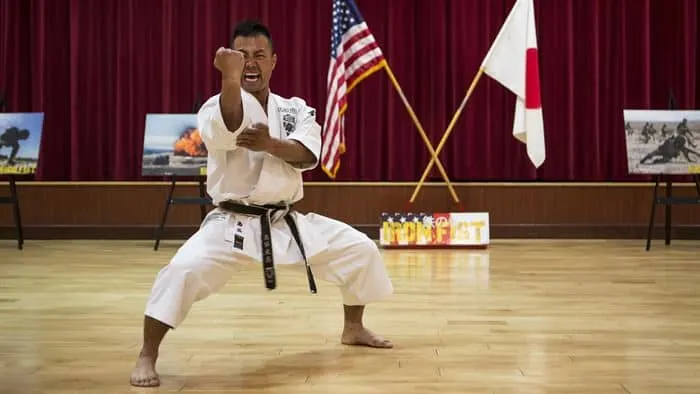
Karate is almost exclusively a striking art featuring punches and in kicks in addition to elbow and knee strikes.
| PROS: The strikes used in Karate are very powerful; in fact Karate strikes are often used to break boards and even bricks during demonstrations. A technique taught in Karate known as the Mae Geri (snapping front kick) provided one of the most famous knockouts in UFC history when Anderson Silva delivered a Mae Geri to the face of Vitor Belfort. The Mawashi Geri (roundhouse kick) is arguably the most powerful kicking technique taught in all of martial arts. This kick is so powerful that it has ended UFC fights when it has connected to the body of an opponent, not just the head. |
| CONS: In an actual fight, Karate style strikes may be too long and slow to be effective. Karate also tends to be more of a hands based technique and less focused on kicks which can connect to an opponent from a longer distance. The fundamentals of some Karate strikes leave the practitioner off balance and prone to counter attacks. |
9. Tae Kwon Do
Tae Kwon Do is a relatively new martial art as it was developed in the 1940’s in Korea by Korean martial artists with backgrounds in older Korean and Chinese martial arts in addition to Karate.
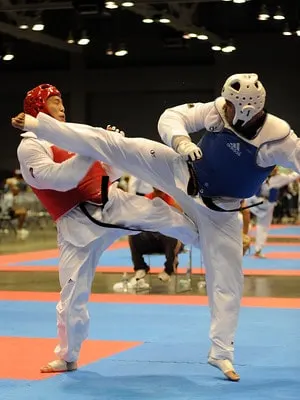
Tae Kwon Do is primarily a kicking based martial art that puts a premium on speed and agility of the practitioner.
One of the main principles of Tae Kwon Do is the speed of the strike is where the power comes from. Tae Kwon Do has been in the Olympics since 2000 and is known for its jumping kicks, spinning kicks, and head high kicks.
| PROS: Tae Kwon Do is great for speed, agility and flexibility. In order to be successful in Tae Kwon Do, a practitioner will have to learn to improve their foot work, foot speed, and flexibility in order to perform the flashy kicks performed in the art. The spinning Tae Kwon Do kick in particular has been shown to be effective in real life fighting, including in the UFC. UFC fighters Cung Lee, and Darren Cruickshank have both used their Tae Kwon Do training to hurt opponents with spinning kicks often to the rib cage or liver. Another positive of Tae Kwon Do is its emphasis on mindset as it contains a focus on mental and ethical discipline as part of its system. |
| CONS: Hand striking is not emphasized in Tae Kwon Do and the few hand strikes that are thrown would not be of use in a real life situation. While the emphasis on speed in Tae Kwon Do gives it an advantage over Karate that speed does come at a cost; because speed is emphasized, the Tae Kwon Do stance is much narrower than the Karate stance making a Tae Kwon Do specialist more susceptible to being taken down. Some of the fancier strikes in Tae Kwon Do are not realistically used in an actual fight because they carry too much risk: miss one of the spinning high kicks in Tae Kwon Do and you find yourself off balance and at risk to any sort of strike or grappling technique from your opponent. |
If you want to learn more about Taekwondo for self-defense, get the full report on Is Taekwondo Effective in a Street Fight? Q&A.
8. Krav Maga
Krav Maga is a military self-defense system that was designed for the Israel Defense Forces and is a combination of boxing, wrestling, aikido, judo, and karate.
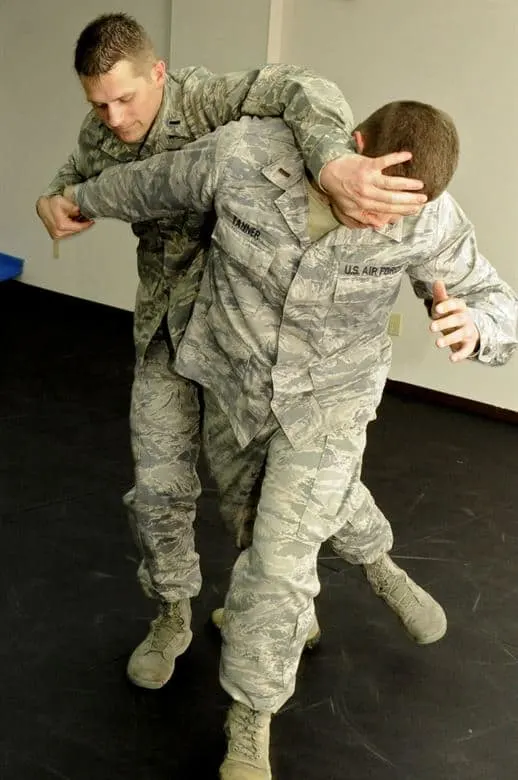
One of the unique aspects of Krav Maga among the first few martial arts listed is that it emphasizes aggression in combat in order to end a confrontation quickly.
Krav Maga promotes strikes and moves aimed at parts of the body other martial arts avoid (such as the eyes and the groin) to accomplish its goal of ending a fight quickly. Unlike Karate, Tae Kwon Do, and many other martial arts that will make this list; there is no sport aspect to Krav Maga as its practice is strictly for combat.
| PROS: Because Krav Maga was designed for the Israeli Defense Forces, its techniques are effective in real life situations. Krav Maga is the only martial art that teaches techniques designed for fighting or disarming someone who has a knife or a gun. Krav Maga also is continually evolving, meaning that the techniques required to reach the next belt level may change over time as fight techniques or dangers change. Krav Maga also teaches physical aggression as its founders believed that it was the most important factor to a confrontation. If you are not a naturally aggressive person, Krav Maga is a great art to consider even to learn that, even if you eventually decide to change to another art form of fighting. Krav Maga balances both stand up fighting techniques and grappling/ground fighting techniques which makes it more effective than Karate and Tae Kwon Do due to its practitioner’s knowledge in all areas where an altercation could take place. |
| CONS: Krav Maga’s techniques are very basic as its founder designed the system to counter attacks from opposing soldiers with weapons. The assumption is that the soldier (or opponent) does not have his or her own martial arts training and will not be able to counter moves once they are disarmed. Many of the techniques learned in Krav Maga would not be effective against a trained martial artist in hand to hand combat as they are too basic. While the teaching of techniques that target the groin and eyes are great for a street fight or an altercation with a criminal, they would be illegal in any sanctioned formed of combat making Krav Maga a poor choice for someone who likes martial arts competition. |
7. Kendo
Kendo is a martial art that uses bamboo swords and has its origins in Japan. Kendo has been around since the 1800’s and was adopted from ancient sword fighting techniques. While it was once only prevalent in Japan, Kendo is now practiced globally.
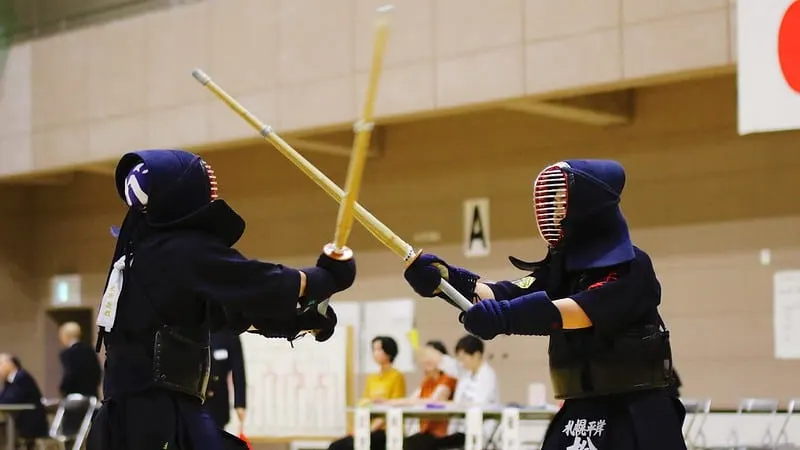
| PROS: Due to its reliance on a sword or stick for its strikes, Kendo is a great martial art for those who lack physical strength due to illness, age, or body size issues. The sword or stick will disable the attacker or the threat if the practitioner performs them correctly, which is not always the case with other martial arts if the practitioner is not powerful or fast. The other advantage of the sword or stick is that the Kendo practitioner can reach their opposition from a distance far enough away that they cannot be hit by a kick or punch. The biggest advantage of Kendo as a martial art is that it is arguably the best martial art to learn in order to deal with multiple attackers. Real life is not the movies and if you find yourself in a situation where you need to defend yourself against multiple people, you will want to have a weapon and know how to use it. |
| CONS: All of the attacks learned in Kendo rely on the use of a sword or a stick, so if you do not have access to one your training will not help you in an altercation. Kendo is not an Olympic event and competition is not especially common outside of Japan making it a martial art that is tough to enjoy beyond just taking lessons and learning the art form. |
6. Judo
Judo was created in Japan in 1882 by Jigoro Kano and features various throws designed to take an adversary to the ground. Once on the ground, a judoka (what a judo practitioner is called) looks to submission holds or chokes to end a contest.

As you might have guessed, Brazilian Jiu-jitsu took a lot of Judo techniques when it was created. Judo has been an Olympic sport since 1964 with a women’s event being added in 1992.
| PROS: One of the biggest selling points of Judo is that it teaches you to take an opponent to the ground without having to use as much energy or strength as wrestling. Because of its emphasis on balance and technique, Judo doesn’t require its practitioners to be as strong or as well conditioned as wrestlers in order to be effective. Ronda Rousey famously took women’s mixed martial arts (and the UFC) by storm as a former Olympic judoka who had great success using her throws to take opponents to the ground and eventually submit them with an armbar or choke. A few years earlier, Karo Parisyan made it all the way to the number one contender spot in the welterweight division of the UFC on the strength of his Judo skills. |
| CONS: While Judo requires less strength and energy than wrestling, its techniques take a long time to master. A Judo practitioner needs to understand leverage, timing, and technique in order to successfully throw their opponent to the ground. The other issue with Judo is that it does not teach any striking and requires the practitioner to get a hold of his or her adversary to practice the art. While Judo is a great counter to a standing based system like Karate, it is not a well rounded martial art for all scenarios of combat. |
5. Boxing
Boxing is arguably the most popular spectator sport of any of the martial arts on this list. The “sweet science” has seen its share of national and international superstars from Rocky Marciano and Muhammad Ali to “Sugar” Ray Leonard and Mike Tyson to today’s Floyd Mayweather and Canelo Alvarez.
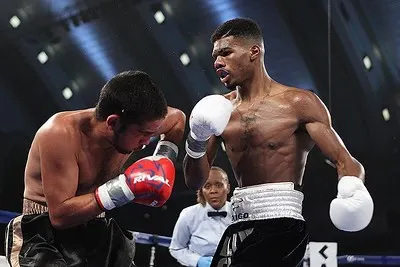
These men reached levels of wealth, fame, and acclaim that simply have not been seen in other forms of martial arts. Boxing has been around since the start of mankind if you consider its origins in hand-to-hand combat and it has been an Olympic sport since 1904.
| PROS: As a purely hand fighting technique, boxing is the best of all the martial arts. It is called the sweet science for a reason as its students learn a variety of different punches (jab, cross, hooks, upper cut) and how to set up their opponent for those different punches. A student of boxing will also learn defense which includes the importance of hand (glove) positioning and head movement for avoidance. One thing that makes boxing especially effective is that particularly smart boxers can have success at an advanced age or when they are out of shape which is not true of all martial arts. Fighters like Muhammad Ali and Floyd Mayweather found success at later ages by avoiding punches and waiting for the right moment to use their skill advantage to win rounds or hurt their opponent. Fighters like James Toney and George Foreman were out of shape in the late stages of their career, but still had the ability to see punches coming and respond with superior power (Foreman) or technique (Toney). In the case of mixed martial arts, it is often a boxing technique that provides a knockout in a big UFC fight. UFC heavyweight fighter Stipe Miocic uses a boxing heavy technique on the feet and smartly used hooks to the body to stop former Olympic wrestler Daniel Cormier to become champion. In addition to being great for the hands and using the mind, boxing also requires a student to learn great footwork in order to be successful. A boxing stance may not be ideal to stop a takedown but the fast feet required in boxing are a positive. |
| CONS: Boxing is too limited as a martial art to take the top spot as it only teaches hand strikes. A boxer is susceptible to kicks and has no training on how to fight off the ground. If a boxer cannot keep the fight standing at a comfortable boxing range, he or she is at a significant disadvantage to an opponent or attacker who has a more diverse skill set from another martial art. |
4. Muay Thai
Muay Thai was developed in Thailand and is a form of kickboxing also known as “the art of eight limbs”. The eight limbs referred to in Muay Thai are the elbows, hands, knees, and shins.
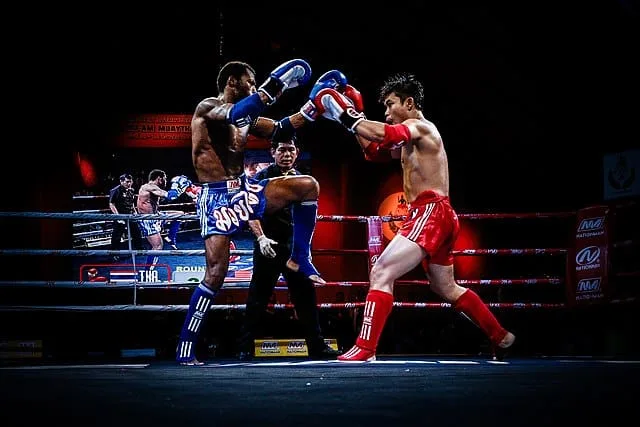
Muay Thai is heavy on kicking similar to Tae Kwon Do, but the kicks are much more straight forward and, therefore, likely to land in actual combat situations. One thing that separates Muay Thai from boxing, or kickboxing, is that clinching an opponent is allowed and part of the strategy of the art.
| PROS: Basically every form of effective stand up technique for fighting purposes is part of Muay Thai. Students of Muay Thai learn punching, elbowing, kneeing, and kicking techniques as well as ways to clinch their opponent to gain an advantage to throw their strikes or prevent strikes against them. The techniques using either the knees or the elbows are fairly unique to Muay Thai and are very effective. MMA fighters have been known to stay in Thailand for a month or more just to learn the art in order to advance their careers. |
| CONS: The punching techniques in Muay Thai are neither as effective nor as diverse as those taught in boxing. Due to an entire Muay Thai fight taking place on the feet, there are no strategies or techniques taught for a fight that goes to the ground. |
You can read more about why boxing is good for self-defense.
3. Wrestling
Wrestling is a grappling based martial art that features take downs, clinch work, holds, and the goal to pin the opponent to the mat. Wrestling has been an Olympic sport since 1904 and is considered an important base for mixed martial artists.
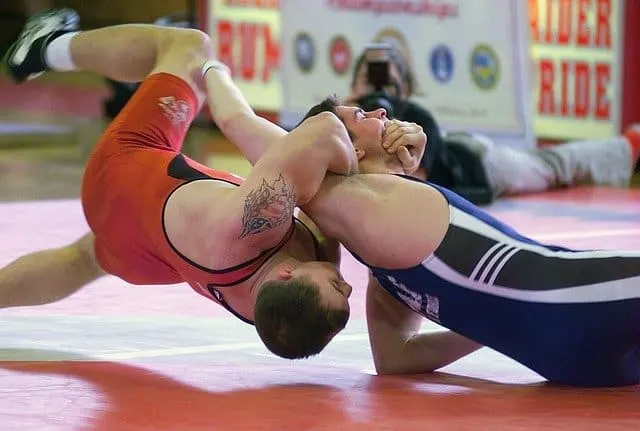
Wrestling is similar to Judo in that both sports revolve around take downs, but wrestling is far more quickness and strength based than the more technique based Judo.
| PROS: Wrestling is easier to learn than Judo and is one of the best ways to negate a good striker in an actual fight. A dominant wrestler can defeat a much more talented and versatile martial artist simply by getting a takedown and practicing the control on the ground that they have trained for. Two of the most dominant champions in UFC history have been Georges St.Pierre and Khabib Nurmagomedov who both use wrestling to control fights and wear down their opposition. |
| CONS: Wrestling is only good for one on one situations as a second attacker could easily punch or kick the wrestler while they were occupied. Wrestling is also a very singular art and does not teach any striking or fight ending techniques. Without learning other martial arts, a wrestler would be in a difficult situation in a real fight against a martial artist trained in striking or grappling techniques that are designed to end fights as opposed to win points. |
2. Brazilian Jiu-Jitsu
A Los Angeles Police Department study found that majority of fights end up on the ground. If that study is correct it shows the value of studying Brazilian Jiu-Jitsu as its joint locks and choke holds can leave an opponent incapacitated in the blink of an eye.
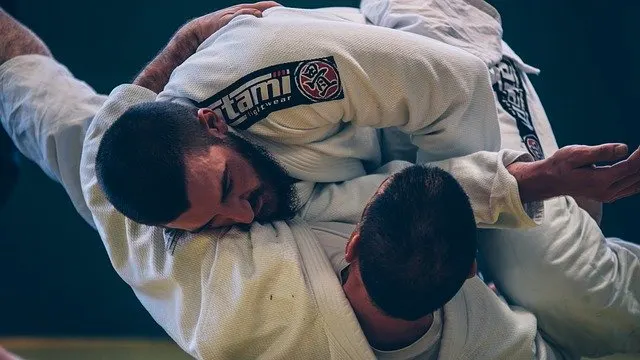
Jiu_Jitsu actually has its origins in Japan and was practiced in that country for more than 50 years before it ever came to Brazil. A stand out Jiu-Jitsu practitioner named Jigoro Kano developed his own style of Jiu-Jitsu that incorporated moves that would later become Judo.
Mitsuo Maeda was a long time student of Kano who would move from Japan to Brazil in 1914. A politician in Brazil, George Gracie, helped Maeda emigrate to Brazil. To show his appreciation for George’s help, Mitsuo would teach George’s son, Carlos, the art of Jiu-Jitsu.
It would be Carlos Gracie who would open Brazil’s first Jiu-Jitsu school in 1925 sharing the knowledge he learned from Mitsuo Maeda. The effectiveness of Brazilian Jiu-Jitsu was demonstrated to the American public through the Gracie family and the early UFC tournaments.
In the early days of the UFC a slightly built Royce Gracie was defeating much larger men by choking them out and leaving them unconscious stunning audiences and creating interest in his family’s Jiu-Jitsu program.
| PROS: Brazilian Jiu-Jitsu is designed so that people of all statures and ages can use it since many of the holds and chokes are technique based as opposed to strength based. Many practitioners of other martial arts are uncomfortable on the ground giving a Brazilian Jiu-Jitsu practitioner a huge advantage in a fight that ends up on the ground as 90% of them supposedly do. Unlike wrestlers or judokas who control their opponent on the ground, Brazilian Jiu-Jitsu players inflict significant damage on their opponents by potentially breaking an ankle or an arm or rendering them unconscious with a choke. Brazilian Jiu-Jitsu is so widely recognized as a dominant martial art that it is now rare for any UFC fighter that is a significant contender to be less than a purple belt (3rd from top rank) in the art. |
| CONS: Much like wrestling, Brazilian Jiu-Jitsu is only for one on one combat. Taking someone to the ground only works in one on one encounters as it leaves you completely vulnerable to a second attacker. The second issue with Brazilian Jiu-Jitsu is that the take downs taught in the art do not work against opponents with strong wrestling or judo backgrounds. Since it does not teach any striking, Brazilian Jiu-Jitsu is entirely reliant on the fight taking place on the ground. |
1. Mixed Martial Arts
Mixed Martial Arts, or MMA, is the combination of many martial arts with the focus on the techniques from each discipline that are most effective for combat.
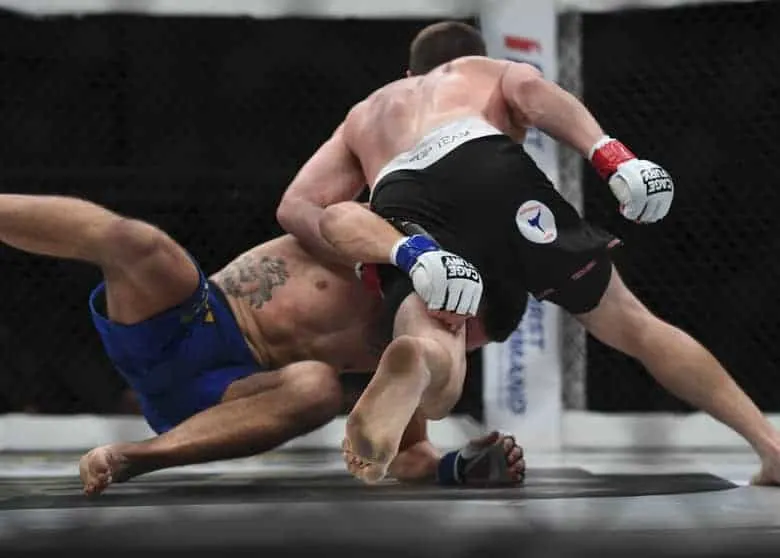
A typical mixed martial artist trains in Brazilian Jiu Jitsu, Boxing, Muay Thai, and Wrestling. With the rise in popularity of mixed martial arts promotions like the UFC, there are more mixed martial arts academies available to train at than ever before.
If there is one criticism of MMA topping this list is that it is more of a fighting system than a martial art on its own. The art of MMA is combining the techniques of the various arts seamlessly to have the most ways to win a fight.
| PROS: Mixed Martial Arts takes the most effective aspects of various arts and combines them to make a well rounded fighter. If you train solely at an MMA gym you will not waste time learning the techniques from Judo, Karate, or Tae Kwon Do that do not translate to actual combat situations. |
| CONS: To become competent at MMA takes a long time as there are so many techniques to learn. The other issue with Mixed Martial Arts is that because you are learning so many techniques, you do not truly become a master at any of them. Someone that only trains Boxing will be better with their hands than an MMA trainee and someone that only trains Brazilian Jiu-Jitsu will be better on the ground. It is truly the time and effort it takes to become competent across a wide spectrum of martial arts that gives an MMA trainee an advantage as opposed to true dominance in one aspect or another. |
Conclusion
In closing, all of these martial arts are excellent choices for someone looking to improve their physical condition, lose weight, gain flexibility or gain confidence in their ability to defend themselves.
Another excellent benefit to studying a martial art is that each of them teaches patience and discipline in response to stressful situations. This focus on the mental aspect of life can benefit you in work, school, and family situations in addition to situations where violence is required.
